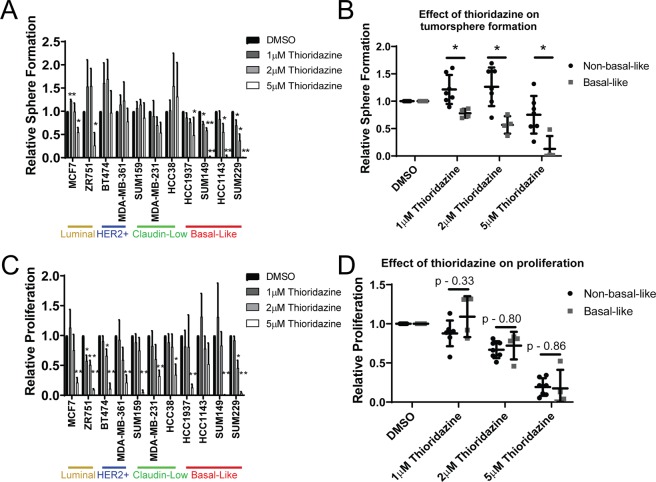Figure 1.
The tumorsphere formation efficiency of basal-like breast cancer cell lines is most sensitive to thioridazine. (A) A panel of 11 breast cancer cell lines were cultured in the tumorsphere assay. Cells were treated once with the indicated concentration of thioridazine. 7 days later, the number spheres formed was assessed. Graph is depicted as the fold-change in sphere formation relative to DMSO control for each cell line. The data from SUM159, MDA-MB-231, HCC38, HCC1937, HCC1143, and SUM149 cells was previously published (16) and combined with other cell lines shown. (B) The effect of thioridazine on tumorsphere formation of each breast cancer cell line, relative to DMSO, is shown. Non-basal-like cells (black circles) are compared to basal-like cell lines (gray squares). (C) A panel of 11 breast cancer cell lines was cultured adherently. Cells were treated once with the indicated concentration of thioridazine. 72 hours later, the number of cells were counted using a hemocytometer. Graph is depicted as the fold-change in cell number relative to DMSO control for each cell line. The data from SUM149 cells was previously published (16) and combined with other cell lines shown. (D) The effect of thioridazine on the proliferation of adherent cells of each breast cancer cell line, relative to DMSO, is shown. Non-basal-like cells (black circles) are compared to basal-like cell lines (gray squares). All experiments were performed in biological triplicates. Error bars represent standard deviation. Significance represents a one-sided t-test in (A,C), testing the difference from DMSO control. Significance in (B,D) was measured with a two-sided t-test. *p < 0.05, **p < 0.01.

